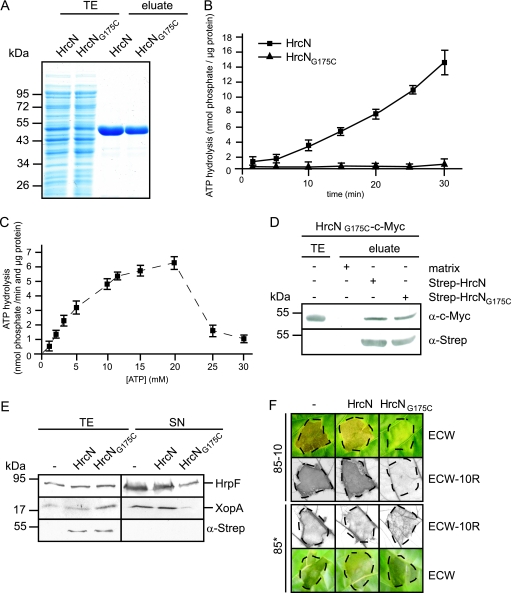FIG. 2.
HrcN hydrolyzes ATP in vitro. (A) Purification of Strep-HrcN and Strep-HrcNG175C. Strep-HrcN and Strep-HrcNG175C were purified from E. coli using Strep-Tactin Sepharose. E. coli total cell extracts (TE) and proteins eluted from the matrix (eluate) were analyzed by SDS-PAGE and stained with Coomassie brilliant blue. (B) ATPase activity of Strep-tagged HrcN. ATP hydrolysis by purified Strep-HrcN and Strep-HrcNG175C was measured using a malachite green phosphatase assay over a period of 30 min after application of malachite green reagent (see Materials and Methods). Error bars indicate standard deviations. (C) ATPase activity of HrcN is inhibited by high substrate concentrations. ATP hydrolysis by purified Strep-HrcN was measured after 10 min as described for panel B at ATP concentrations ranging from 1 to 30 mM. (D) HrcNG175C self-interacts and interacts with wild-type HrcN. Strep-HrcN and Strep-HrcNG175C were immobilized on a Sepharose matrix and incubated with an E. coli lysate containing HrcNG175C-c-Myc. As a negative control, HrcNG175C-c-Myc was incubated with the matrix alone. The total extract of hrcNG175C-c-myc-expressing E. coli (TE) and eluted proteins (eluate) were analyzed by immunoblotting using c-Myc- and Strep-specific antibodies. (E) Overexpression of Strep-hrcNG175C affects in vitro T3S of HrpF and XopA. Strain 85* carrying the empty vector (−) or synthesizing Strep-HrcN and Strep-HrcNG175C as indicated was incubated in secretion medium. Total protein extracts (TE) and culture supernatants (SN) were analyzed by immunoblotting using antibodies directed against HrpF, XopA, and the Strep epitope. (F) Overexpression of Strep-hrcNG175C affects bacterial pathogenicity. X. campestris pv. vesicatoria strains 85-10 and 85* carrying the empty vector (−) or synthesizing Strep-HrcN or Strep-HrcNG175C as indicated were inoculated into susceptible ECW and resistant ECW-10R pepper plants. For better visualization of the HR, leaves were bleached in ethanol 3 days after inoculation. Disease symptoms were photographed 7 days after inoculation. Dashed lines indicate the inoculated areas.

